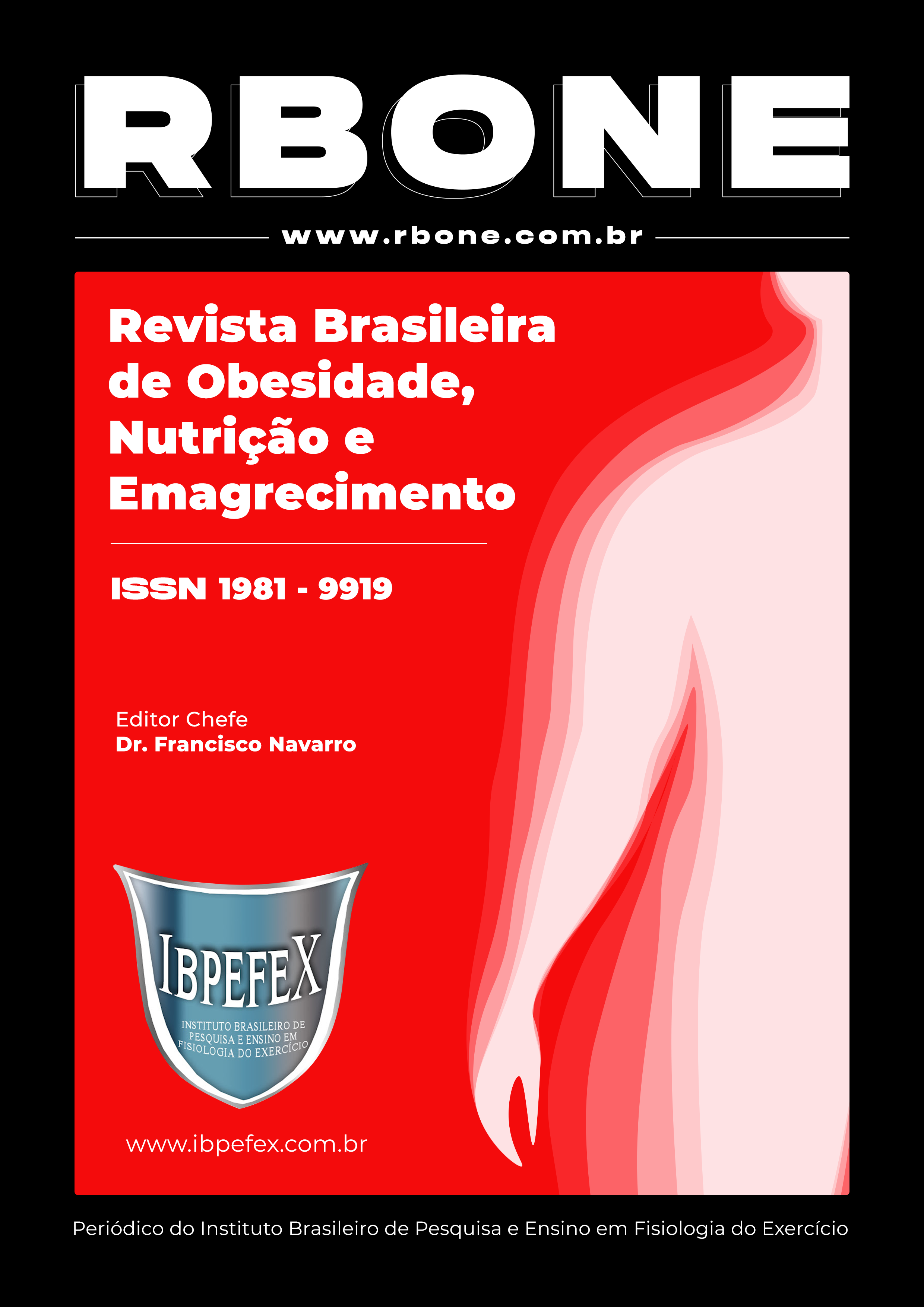Nutritional status, eating habits and physical exercise among women with polycystic ovary syndrome
Abstract
Visual impairment is characterized as a loss of visual capacity that cannot be fully corrected with refractive correction or surgery, causing a limitation in the performance of everyday tasks. The objective was to investigate the nutritional status of individuals with visual impairment attended at a school located in the city of Pelotas-RS. It was a cross-sectional observational study, with adults and elderly people who have different degrees of visual impairment. A questionnaire consisting of 42 items was used to obtain data in addition to the anthropometric measurements that were taken to assess body composition, nutritional status and risk of non-communicable chronic diseases. 20 people, predominantly female, elderly and single, took part in the study. It was found that 55% of the participants were overweight. Furthermore, it was found that 50% of men and 60% of women were at risk of metabolic complications associated with central obesity due to high waist circumference. Therefore, individuals with visual impairments in this study showed a high prevalence of overweight and obesity.
References
-Alves, M. G. Ocorrência das principais doenças crônicas em pessoas com deficiência visual em Campina Grande-PB. TCC de Graduação em Farmácia. Universidade Estadual da Paraíba. Campina Grande. 2018.
-Bezerra. P. F. Circunferência da panturrilha em pacientes idosos atendidos em uma unidade de alta complexidade em oncologia. VI Congresso de Educação em Saúde da Amazônia (COESA), Universidade Federal do Pará. 7 a 10 de novembro de 2017.
-Brasil. Ministério da Saúde. Resolução 466/12 sobre pesquisa envolvendo seres humanos. Brasília, DF, Ministério da Saúde. 2012. Disponível em: https://conselho.saude.gov.br/resolucoes/2012/Reso466.pdf Acesso em 06/02/ 2022.
-Court, H.; Mclean, G.; Gutrie, B. e colaboradores. Visual impairment is associated with physical and mental comorbidities in older adults: a crosssectional study. BMC Medicine. 2014. doi: 10.1186/s12916-014-0181-7
-Estevam, J. Dificuldades na aquisição, preparo e consumo de alimentos vivenciadas por pessoas com deficência visual. TCC de Graduação em Nutrição. Universidade Federal do Rio Grande do Norte. 2019.
-GBD 2019 Blindness and Vision Impairment Collaborators; Vision Loss Expert Group of the Global Burden of Disease Study. Causes of blindness and vision impairment in 2020 and trends over 30 years, and prevalence of avoidable blindness in relation to VISION 2020: the Right to Sight: an analysis for the Global Burden of Disease Study. Lancet Glob Health. 2021 doi: 10.1016/S2214-109X(20)30489-7
-Jones, N.; Bartlett, H.E.; Cooke, R. An analysis of the impact of visual impairment on activities of daily living and vision-related quality of life in a visually impaired adult population. British Journal of Visual Impairment. Vol. 37. 2019. p. 50-63.
-Lipschitz, D.A. Screening for nutritional status in the elderly. Primary Care. Vol. 21. Num. 1. 1994. p. 55-67
-Lohman, T.G.; Roche, A.F.; Martorell, R. Anthropometric standardization reference manual. Human Kinetics. Books. Chicago. 1988.
-Melo, S.A.; e colaboradores. Análise da imagem corporal e prática de atividade física em pessoas com deficiência visual em Teresina-PÍ. Revista. Benjamin Constant. Rio de Janeiro. Vol. 87. 2021.
-Naipal. S.; Rampersad. N. A review of visual impairment. Afr Vision Eye Health. 2018. https://doi. org/10.4102/aveh.v77i1.393
-OMS. Organização Mundial da Saúde. Physical status: the use and interpretation of anthropometry. Genebra. 1995.
-OMS. Organização Mundial da Saúde. Organização Mundial da Saúde. Relatório mundial sobre a visão. 2021.
-OMS. Organização Mundial da Saúde. Blindness and vision impairment. 2022. Disponível em: https://www.who.int/news-room/fact-sheets/detail/blindness-and-visual-impairment.
-Pagotto, V. Circunferência da panturrilha: validação clínica para avaliação de massa muscular em idosos. Rev Bras Enferm. 2018. https://doi.org/10.1590/0034-7167-2017-0121
-Peres, R. J.; e colaboradores. Insatisfação com a imagem corporal entre pessoas com deficiência visual. Revista Brasileira de Ciência do Esporte. Vol. 37. 2015. p. 362-366. https://doi.org/10.1016/j.rbce.2015.08.013
-PNS. Painel de Indicadores de Saúde. Pesquisa Nacional de Saúde. Pessoas com deficiência visual. 2019. Disponível em: https://www.pns.icict.fiocruz.br/painel-de-indicadores-mobile-desktop/. Acesso em: 01/05/23.
-Scherer, R. L.; Karasiak, F.C.; Borgatto, S.F. Fatores associados à atividade física na deficiência visual. Educación Física y Ciencia. 2018. https://doi.org/10.24215/23142561e0647
-Verma, M.; Rajput, M.; Sahoo, S.S. e colaboradores. Neck circumference: independent predictor for overweight and obesity in adult population. Indian J Community Med. Vol. 42. Num. 4. 2017. p. 209-213.
Copyright (c) 2024 Andrew Sacilotto de Bairro Romancini, Tiffany Prokopp Hautrive, Anne Y Castro Marques, Cristina Bossle de Castilhos

This work is licensed under a Creative Commons Attribution-NonCommercial 4.0 International License.
Authors who publish in this journal agree to the following terms:
- Authors retain the copyright and grant the journal the right of first publication, with work simultaneously licensed under the Creative Commons Attribution License BY-NC which allows the sharing of the work with acknowledgment of the authorship of the work and initial publication in this journal.
- Authors are authorized to enter into additional contracts separately for non-exclusive distribution of the version of the work published in this journal (eg, publishing in institutional repository or book chapter), with acknowledgment of authorship and initial publication in this journal.
- Authors are allowed and encouraged to post and distribute their work online (eg, in institutional repositories or on their personal page) at any point before or during the editorial process, as this can bring about productive change as well as increase impact and impact. citation of published work (See The Effect of Free Access).






